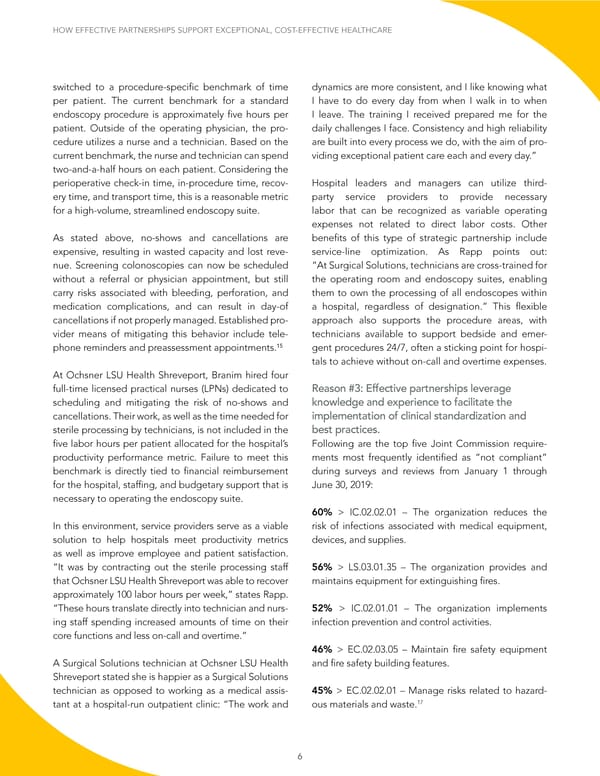HOW EFFECTIVE PARTNERSHIPS SUPPORT EXCEPTIONAL, COST-EFFECTIVE HEALTHCARE switched to a procedure-specific benchmark of time dynamics are more consistent, and I like knowing what per patient. The current benchmark for a standard I have to do every day from when I walk in to when endoscopy procedure is approximately five hours per I leave. The training I received prepared me for the patient. Outside of the operating physician, the pro- daily challenges I face. Consistency and high reliability cedure utilizes a nurse and a technician. Based on the are built into every process we do, with the aim of pro- current benchmark, the nurse and technician can spend viding exceptional patient care each and every day.” two-and-a-half hours on each patient. Considering the perioperative check-in time, in-procedure time, recov- Hospital leaders and managers can utilize third- ery time, and transport time, this is a reasonable metric party service providers to provide necessary for a high-volume, streamlined endoscopy suite. labor that can be recognized as variable operating expenses not related to direct labor costs. Other As stated above, no-shows and cancellations are benefits of this type of strategic partnership include expensive, resulting in wasted capacity and lost reve- service-line optimization. As Rapp points out: nue. Screening colonoscopies can now be scheduled “At Surgical Solutions, technicians are cross-trained for without a referral or physician appointment, but still the operating room and endoscopy suites, enabling carry risks associated with bleeding, perforation, and them to own the processing of all endoscopes within medication complications, and can result in day-of a hospital, regardless of designation.” This flexible cancellations if not properly managed. Established pro- approach also supports the procedure areas, with vider means of mitigating this behavior include tele- technicians available to support bedside and emer- 15 phone reminders and preassessment appointments. gent procedures 24/7, often a sticking point for hospi- tals to achieve without on-call and overtime expenses. At Ochsner LSU Health Shreveport, Branim hired four full-time licensed practical nurses (LPNs) dedicated to Reason #3: Effective partnerships leverage scheduling and mitigating the risk of no-shows and knowledge and experience to facilitate the cancellations. Their work, as well as the time needed for implementation of clinical standardization and sterile processing by technicians, is not included in the best practices. five labor hours per patient allocated for the hospital’s Following are the top five Joint Commission require- productivity performance metric. Failure to meet this ments most frequently identified as “not compliant” benchmark is directly tied to financial reimbursement during surveys and reviews from January 1 through for the hospital, staffing, and budgetary support that is June 30, 2019: necessary to operating the endoscopy suite. 60% > IC.02.02.01 – The organization reduces the In this environment, service providers serve as a viable risk of infections associated with medical equipment, solution to help hospitals meet productivity metrics devices, and supplies. as well as improve employee and patient satisfaction. “It was by contracting out the sterile processing staff 56% > LS.03.01.35 – The organization provides and that Ochsner LSU Health Shreveport was able to recover maintains equipment for extinguishing fires. approximately 100 labor hours per week,” states Rapp. “These hours translate directly into technician and nurs- 52% > IC.02.01.01 – The organization implements ing staff spending increased amounts of time on their infection prevention and control activities. core functions and less on-call and overtime.” 46% > EC.02.03.05 – Maintain fire safety equipment A Surgical Solutions technician at Ochsner LSU Health and fire safety building features. Shreveport stated she is happier as a Surgical Solutions technician as opposed to working as a medical assis- 45% > EC.02.02.01 – Manage risks related to hazard- tant at a hospital-run outpatient clinic: “The work and ous materials and waste.17 6
 Driving Efficiency & Throughput Page 6 Page 8
Driving Efficiency & Throughput Page 6 Page 8